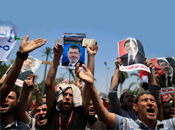
Recently, I have been suggesting a narrow trading band for both West Texas Intermediate (WTI) and Brent crude in London. They're trading today at about $96.00 and $103.00, respectively.
But two developments are threatening to heat things up yet again—and fast.
One is the wild card of geopolitical events, which can be a catalyst for rapid gyrations in oil prices. The other is a factor rising inside the oil market itself (which I'll get to in a moment).
The first—and the primary subject matter for this afternoon's appearance—involves the renewed unrest in Egypt. Fox is going to be primarily interested in how this impacts oil availability and pricing.
But my take goes a bit beyond the current situation in Cairo—1,204 miles east, to be precise.
For the biggest oil price concerns, look to this tiny island nation. . .
Egypt is introducing uncertainty, which is only accelerated by the military's threat to intervene by the end of this week if President Mohamed Morsi and the opposition cannot reach a compromise. Widespread demonstrations against Morsi began this week, one year after his election, and now threaten to divide the country further.
Oil will experience rising volatility, especially in Europe, where Middle East unrest is felt much quicker than in North America, but Egypt has little to do directly with most oil used in Europe. An interruption of traffic on the Suez Canal, of course, would be quite another matter. But there is no indication and little genuine likelihood that the unrest would ever reach that point.
A move in by the military would end the present democratic experiment in the country, but there is a rising belief among observers that short-term order may be unavailable otherwise.
This is quickly shaping up to be the next stage in an ongoing wave of popular unrest in the Middle East and North Africa (now referred to collectively by analysts as "MENA"). As such, Egypt is the first chapter, not the last, and while it is the media focus du jour, it is not likely to be the primary problem for oil.
The real concerns for oil will be coming from other problems in the region.
Already, protests are increasing again in Libya, with the result of reducing oil production. Any threat to an interruption of significant volume from the North African country will spike oil prices in Europe directly. That is because most of that oil goes directly to the continent, rather than either North America or Asia.
But again, that's only part of it.
The main problem in the region is Bahrain.
This tiny island country sticks out into the Persian Gulf connected to Saudi Arabia by a causeway. It is of no consequence in oil production by itself, but the bridge connects it to the main Saudi eastern oil production province. Rising unrest there could be the most direct cause of widespread supply disruption and a major wave of instability throughout MENA.
This is because the conflict in Bahrain is the only one centered on a Sunni-Shiite division.
A disagreement between the two sects of Islam spilling into the streets anywhere in MENA will prompt similar animosity everywhere else. It is the fuel for an explosion across the entire face of the region.
But it is already a crisis in Bahrain, where a Sunni minority ruling family (headed by King Hamad bin Isa Al Khalifa) faces a population that is majority Shiite. That opposition is actively supported by the Shiite-dominated Iran, with support also coming from the Shiite southern part of Iraq.
The complication is intensified over the border in Saudi Arabia, where the primary oil-producing area is predominantly Shiite. In 1979, when the religiously-inspired revolution swept Iran, this eastern Saudi province also erupted, requiring Riyadh put it down militarily.
As a result, when Bahraini problems first emerged in 2011, Saudi authorities did not wait for developments. They marched their police and military across the causeway to maintain order inside another country.
This is the powder keg that could ignite the entire area and put the bulk of current global oil production at risk.
The second development causing oil prices to heat up is more straightforward. We are witnessing a rise in demand worldwide with indications that present inventories in the U.S. will be declining. The surplus at Cushing, Oklahoma last week was at its lowest level in some time. This becomes another upward pressure on crude prices.
Then combination of MENA uncertainty (the geopolitical factor) and inventory/demand (the market factor) is now coming into focus. I will suggest to the audience this afternoon that there are two short-term ways investors can play this, both centering upon the likely rise in Brent accompanying the instability.
Both of these are well-known to Energy Advantage subscribers, since they have been part of our Portfolio for some time. Both are exchange-traded funds (ETFs) and will rise as Brent increases.
The United States Brent Oil Fund (NYSEArca:BNO) is a direct dollar-denominated way to move on the Brent price hike. Meanwhile, PowerShares DB Energy Fund (NYSEArca:DBE) is a convenient way to play the difference between Brent and WTI on the one hand, and how that difference translates into selected "crack spreads" (the differential between crude oil prices and those for major oil products, primarily gasoline and low sulfur content heating oil.
The summer is certainly starting to heat up, and it's not just about what the thermometer is reading.
Kent Moors
Oil & Energy Investor

























































